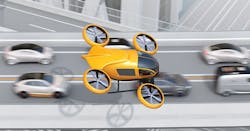It was caged and only hovered for about a minute, but it flew: a new flying car.
Made by NEC Corp., the vehicle is essentially a large drone with four propellers that’s capable of carrying people. The Japanese electronics maker demonstrated the machine, flying without a passenger, at a Tokyo suburb on Monday. Powered by a battery, it rose briefly to about 3 meters (10 ft.) above the ground before settling down again.
A prototype of NEC's flying car. Photographer: Kiyoshi Ota/Bloomberg
Behind the somewhat underwhelming, drama-free demonstration lies a bigger ambition: Japan’s government wants the country to become a leader in flying cars after missing out on advancements in technology such as electric cars and ride-hailing services. The country’s technological roadmap calls for shipping goods by flying cars by around 2023 and letting people ride in flying cars in cities by the 2030s.
“Japan is a densely populated country and that means flying cars could greatly alleviate the burden on road traffic,” said Kouji Okada, a leader of the project at NEC. “We are positioning ourselves as an enabler for air mobility, providing location data and building communications infrastructure for flying cars.”
For the past few years, Japan has seen the emergence of a small, passionate flying-car community that believes Japan has the engineering expertise and right environment to foster a global flying car industry. Venture capitalists in the country set up a specialized fund, known as the Drone Fund, devoted to investing in autonomous aircraft in general and flying-car businesses in particular.
Read more: The Birthplace of the Walkman Wants to Be First in Flying Cars
Although Monday’s demo is among the first by a major Japanese corporation, NEC isn’t planning to mass-produce the flying car, according to Okada. Instead project partner Cartivator will start mass producing the transportation machine in 2026, according to the startup’s co-founder, Tomohiro Fukuzawa.
A prototype of NEC's flying car. Photographer: Kiyoshi Ota/Bloomberg
NEC engineers and Cartivator, which it sponsors, spent about a year developing the model. It’s about 3.9 meters long, 3.7 meters wide and 1.3 meters tall, and weighs about 150 kilograms. It’s being tested in a large 10-meter-by-20-meter cage that’s 2 meters tall, to make sure it doesn’t fly out of control and injure someone, or cause damage.
Japan isn’t the only country seeking to usher in a flying-car utopia; Dubai, Singapore, and New Zealand have expressed similar intentions. Google co-founder Larry Page’s Kitty Hawk Corp. is also working on a flying car, as is Uber Technologies Inc.
Eventually, NEC’s flying car will be set free: Cartivator has been granted a permit for outdoor flights by Japanese government.
About the Author
Bloomberg
Licensed content from Bloomberg, copyright 2016.
